Melanie's Chronic Renal Failure: Advanced Pathophysiology Report
VerifiedAdded on 2022/09/28
|14
|3317
|28
Report
AI Summary
This report presents a comprehensive analysis of a case study involving a 55-year-old patient, Melanie Johnson, diagnosed with chronic renal failure. The report begins with a brief overview of renal anatomy and physiology, followed by a detailed discussion of the pathophysiology of chronic renal failure in Melanie's case, including her risk factors (family history, age, use of NSAIDs, and hypertension), possible complications (crystalline arthritis, anemia, and hyperkalemia), and treatment options (lifestyle changes, medication, and renal replacement therapy). The report then differentiates between chronic and acute renal failure and discusses renal replacement therapy options, specifically linking them to Melanie's case. Part two of the report focuses on the two medications used for Melanie, Valsartan and Eprex, providing the rationale for their use, major side effects, and relevant nursing considerations. The report also analyzes Melanie's GFR and Hb blood test results, explaining what they indicate. Finally, it explores the teach-back method as a strategy for patient education and management of chronic renal failure, emphasizing the importance of clear communication and patient understanding. The report is a valuable resource for understanding the complexities of chronic renal failure management.
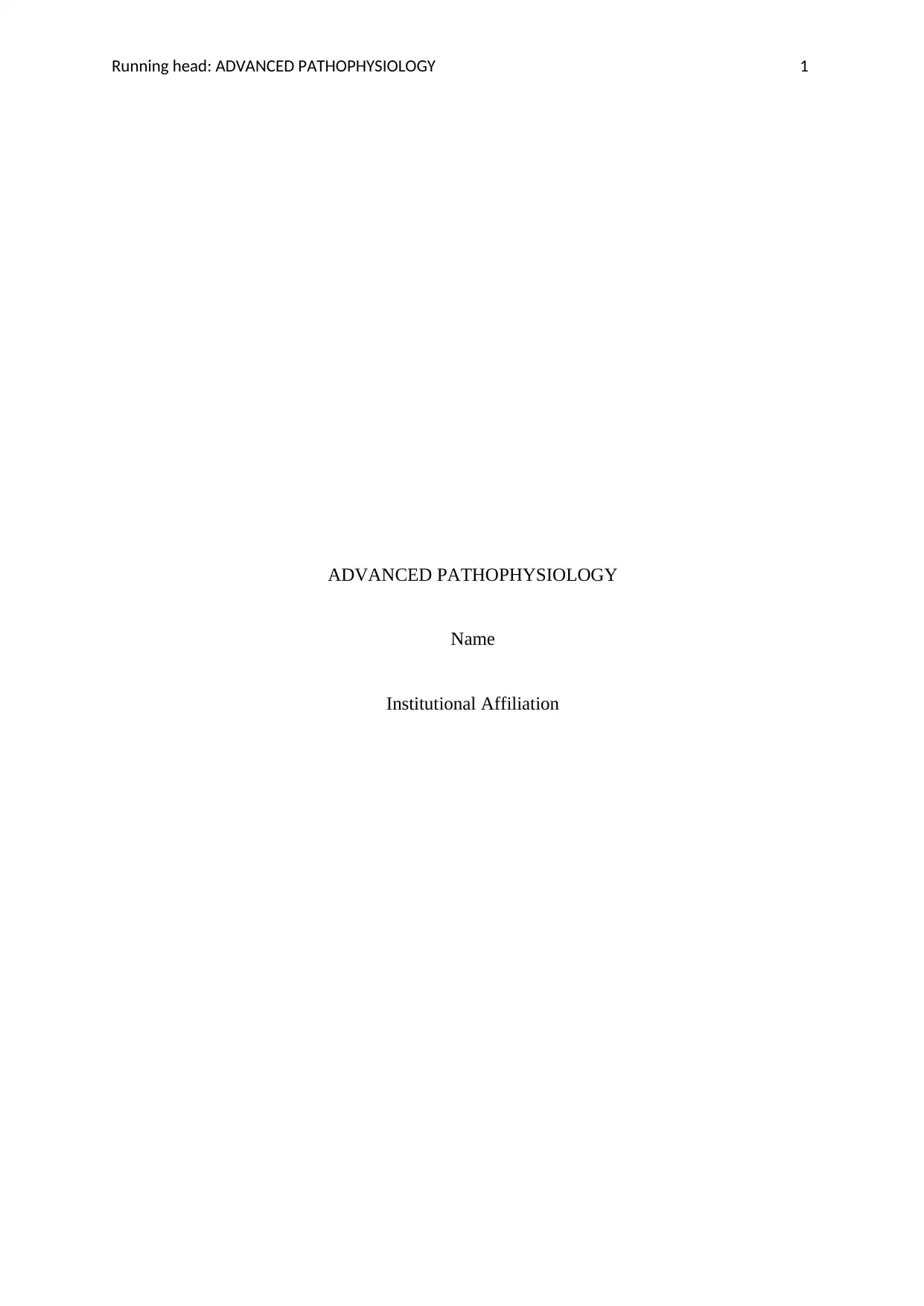
Running head: ADVANCED PATHOPHYSIOLOGY 1
ADVANCED PATHOPHYSIOLOGY
Name
Institutional Affiliation
ADVANCED PATHOPHYSIOLOGY
Name
Institutional Affiliation
Paraphrase This Document
Need a fresh take? Get an instant paraphrase of this document with our AI Paraphraser
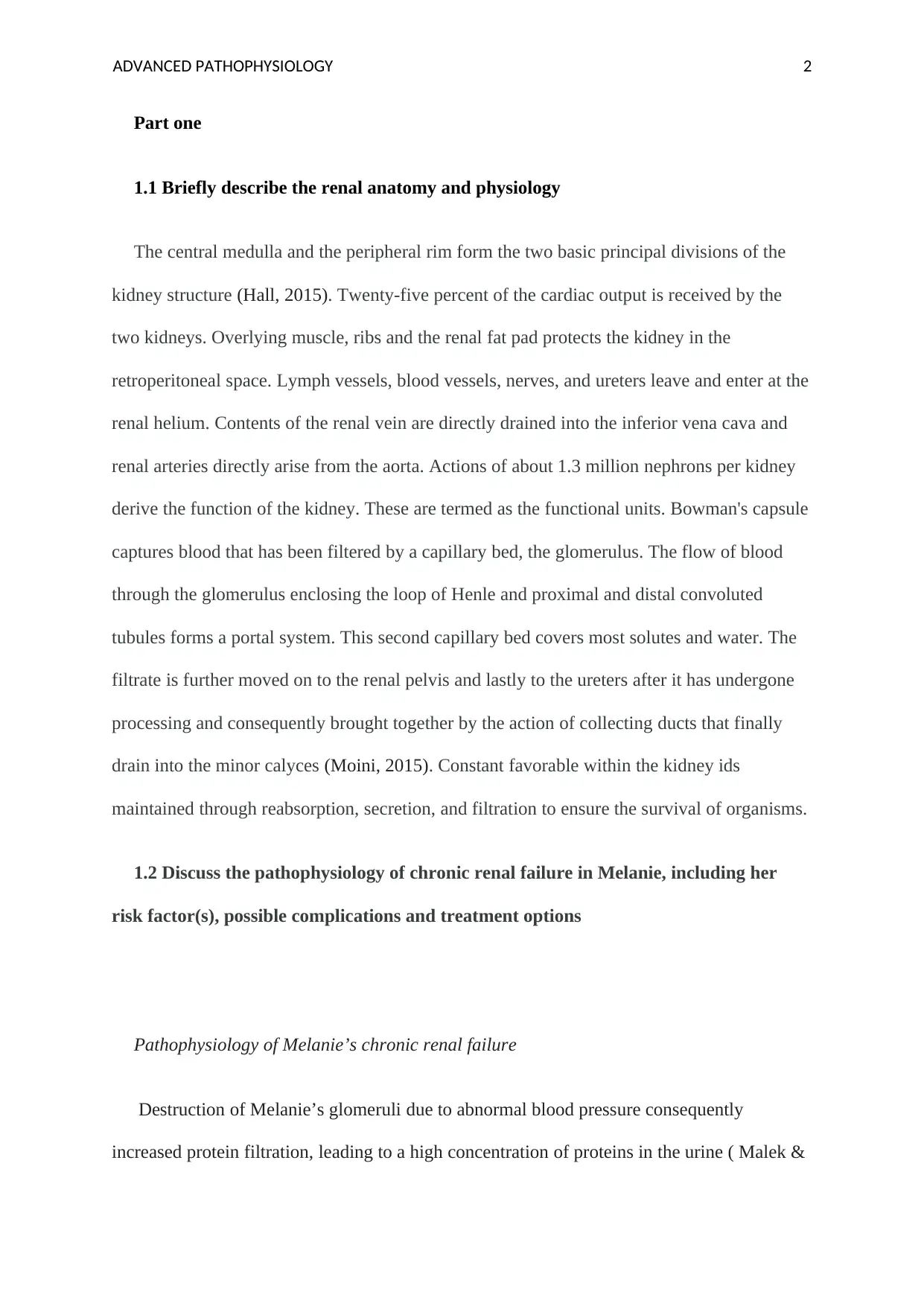
ADVANCED PATHOPHYSIOLOGY 2
Part one
1.1 Briefly describe the renal anatomy and physiology
The central medulla and the peripheral rim form the two basic principal divisions of the
kidney structure (Hall, 2015). Twenty-five percent of the cardiac output is received by the
two kidneys. Overlying muscle, ribs and the renal fat pad protects the kidney in the
retroperitoneal space. Lymph vessels, blood vessels, nerves, and ureters leave and enter at the
renal helium. Contents of the renal vein are directly drained into the inferior vena cava and
renal arteries directly arise from the aorta. Actions of about 1.3 million nephrons per kidney
derive the function of the kidney. These are termed as the functional units. Bowman's capsule
captures blood that has been filtered by a capillary bed, the glomerulus. The flow of blood
through the glomerulus enclosing the loop of Henle and proximal and distal convoluted
tubules forms a portal system. This second capillary bed covers most solutes and water. The
filtrate is further moved on to the renal pelvis and lastly to the ureters after it has undergone
processing and consequently brought together by the action of collecting ducts that finally
drain into the minor calyces (Moini, 2015). Constant favorable within the kidney ids
maintained through reabsorption, secretion, and filtration to ensure the survival of organisms.
1.2 Discuss the pathophysiology of chronic renal failure in Melanie, including her
risk factor(s), possible complications and treatment options
Pathophysiology of Melanie’s chronic renal failure
Destruction of Melanie’s glomeruli due to abnormal blood pressure consequently
increased protein filtration, leading to a high concentration of proteins in the urine ( Malek &
Part one
1.1 Briefly describe the renal anatomy and physiology
The central medulla and the peripheral rim form the two basic principal divisions of the
kidney structure (Hall, 2015). Twenty-five percent of the cardiac output is received by the
two kidneys. Overlying muscle, ribs and the renal fat pad protects the kidney in the
retroperitoneal space. Lymph vessels, blood vessels, nerves, and ureters leave and enter at the
renal helium. Contents of the renal vein are directly drained into the inferior vena cava and
renal arteries directly arise from the aorta. Actions of about 1.3 million nephrons per kidney
derive the function of the kidney. These are termed as the functional units. Bowman's capsule
captures blood that has been filtered by a capillary bed, the glomerulus. The flow of blood
through the glomerulus enclosing the loop of Henle and proximal and distal convoluted
tubules forms a portal system. This second capillary bed covers most solutes and water. The
filtrate is further moved on to the renal pelvis and lastly to the ureters after it has undergone
processing and consequently brought together by the action of collecting ducts that finally
drain into the minor calyces (Moini, 2015). Constant favorable within the kidney ids
maintained through reabsorption, secretion, and filtration to ensure the survival of organisms.
1.2 Discuss the pathophysiology of chronic renal failure in Melanie, including her
risk factor(s), possible complications and treatment options
Pathophysiology of Melanie’s chronic renal failure
Destruction of Melanie’s glomeruli due to abnormal blood pressure consequently
increased protein filtration, leading to a high concentration of proteins in the urine ( Malek &
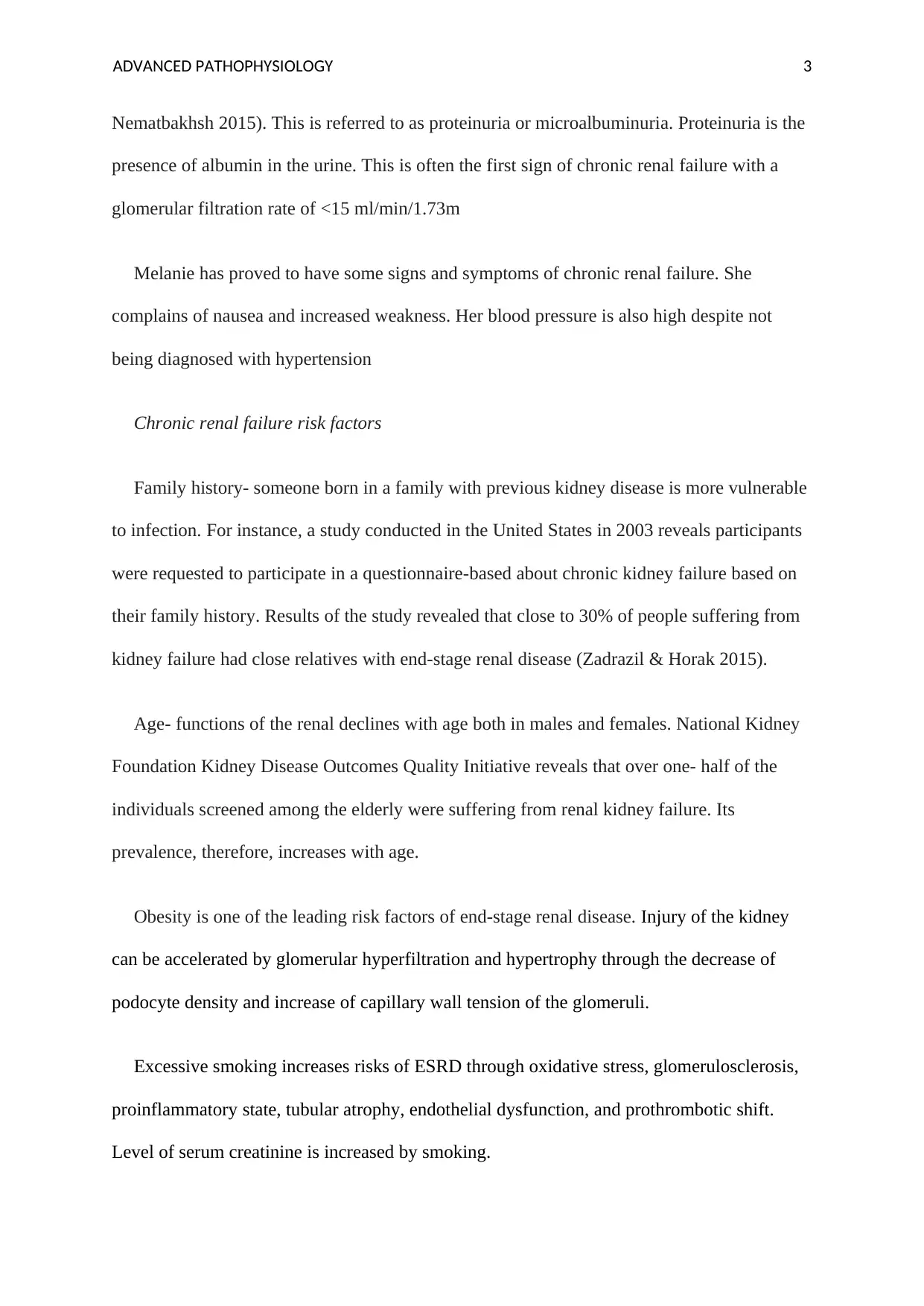
ADVANCED PATHOPHYSIOLOGY 3
Nematbakhsh 2015). This is referred to as proteinuria or microalbuminuria. Proteinuria is the
presence of albumin in the urine. This is often the first sign of chronic renal failure with a
glomerular filtration rate of <15 ml/min/1.73m
Melanie has proved to have some signs and symptoms of chronic renal failure. She
complains of nausea and increased weakness. Her blood pressure is also high despite not
being diagnosed with hypertension
Chronic renal failure risk factors
Family history- someone born in a family with previous kidney disease is more vulnerable
to infection. For instance, a study conducted in the United States in 2003 reveals participants
were requested to participate in a questionnaire-based about chronic kidney failure based on
their family history. Results of the study revealed that close to 30% of people suffering from
kidney failure had close relatives with end-stage renal disease (Zadrazil & Horak 2015).
Age- functions of the renal declines with age both in males and females. National Kidney
Foundation Kidney Disease Outcomes Quality Initiative reveals that over one- half of the
individuals screened among the elderly were suffering from renal kidney failure. Its
prevalence, therefore, increases with age.
Obesity is one of the leading risk factors of end-stage renal disease. Injury of the kidney
can be accelerated by glomerular hyperfiltration and hypertrophy through the decrease of
podocyte density and increase of capillary wall tension of the glomeruli.
Excessive smoking increases risks of ESRD through oxidative stress, glomerulosclerosis,
proinflammatory state, tubular atrophy, endothelial dysfunction, and prothrombotic shift.
Level of serum creatinine is increased by smoking.
Nematbakhsh 2015). This is referred to as proteinuria or microalbuminuria. Proteinuria is the
presence of albumin in the urine. This is often the first sign of chronic renal failure with a
glomerular filtration rate of <15 ml/min/1.73m
Melanie has proved to have some signs and symptoms of chronic renal failure. She
complains of nausea and increased weakness. Her blood pressure is also high despite not
being diagnosed with hypertension
Chronic renal failure risk factors
Family history- someone born in a family with previous kidney disease is more vulnerable
to infection. For instance, a study conducted in the United States in 2003 reveals participants
were requested to participate in a questionnaire-based about chronic kidney failure based on
their family history. Results of the study revealed that close to 30% of people suffering from
kidney failure had close relatives with end-stage renal disease (Zadrazil & Horak 2015).
Age- functions of the renal declines with age both in males and females. National Kidney
Foundation Kidney Disease Outcomes Quality Initiative reveals that over one- half of the
individuals screened among the elderly were suffering from renal kidney failure. Its
prevalence, therefore, increases with age.
Obesity is one of the leading risk factors of end-stage renal disease. Injury of the kidney
can be accelerated by glomerular hyperfiltration and hypertrophy through the decrease of
podocyte density and increase of capillary wall tension of the glomeruli.
Excessive smoking increases risks of ESRD through oxidative stress, glomerulosclerosis,
proinflammatory state, tubular atrophy, endothelial dysfunction, and prothrombotic shift.
Level of serum creatinine is increased by smoking.
⊘ This is a preview!⊘
Do you want full access?
Subscribe today to unlock all pages.

Trusted by 1+ million students worldwide
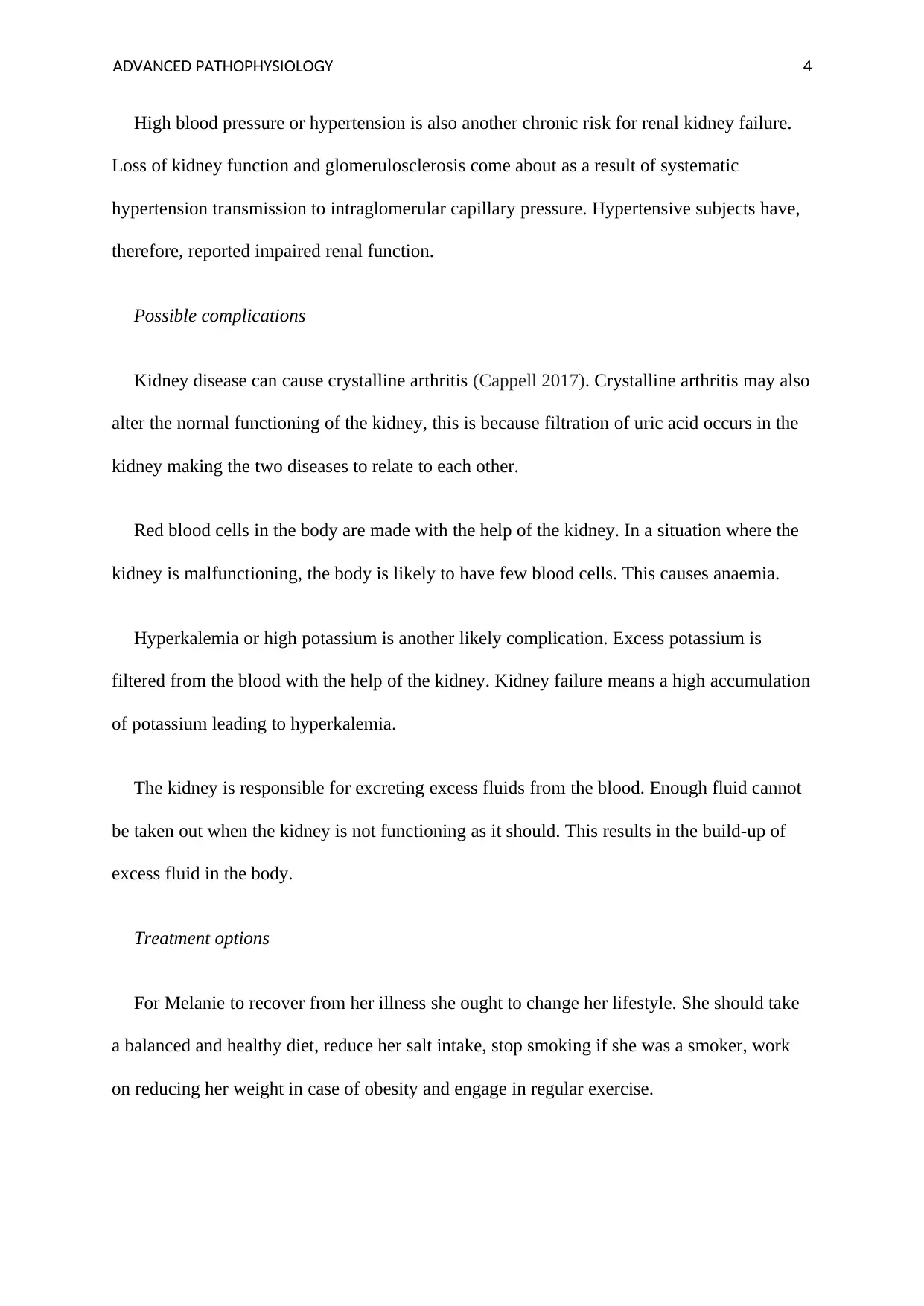
ADVANCED PATHOPHYSIOLOGY 4
High blood pressure or hypertension is also another chronic risk for renal kidney failure.
Loss of kidney function and glomerulosclerosis come about as a result of systematic
hypertension transmission to intraglomerular capillary pressure. Hypertensive subjects have,
therefore, reported impaired renal function.
Possible complications
Kidney disease can cause crystalline arthritis (Cappell 2017). Crystalline arthritis may also
alter the normal functioning of the kidney, this is because filtration of uric acid occurs in the
kidney making the two diseases to relate to each other.
Red blood cells in the body are made with the help of the kidney. In a situation where the
kidney is malfunctioning, the body is likely to have few blood cells. This causes anaemia.
Hyperkalemia or high potassium is another likely complication. Excess potassium is
filtered from the blood with the help of the kidney. Kidney failure means a high accumulation
of potassium leading to hyperkalemia.
The kidney is responsible for excreting excess fluids from the blood. Enough fluid cannot
be taken out when the kidney is not functioning as it should. This results in the build-up of
excess fluid in the body.
Treatment options
For Melanie to recover from her illness she ought to change her lifestyle. She should take
a balanced and healthy diet, reduce her salt intake, stop smoking if she was a smoker, work
on reducing her weight in case of obesity and engage in regular exercise.
High blood pressure or hypertension is also another chronic risk for renal kidney failure.
Loss of kidney function and glomerulosclerosis come about as a result of systematic
hypertension transmission to intraglomerular capillary pressure. Hypertensive subjects have,
therefore, reported impaired renal function.
Possible complications
Kidney disease can cause crystalline arthritis (Cappell 2017). Crystalline arthritis may also
alter the normal functioning of the kidney, this is because filtration of uric acid occurs in the
kidney making the two diseases to relate to each other.
Red blood cells in the body are made with the help of the kidney. In a situation where the
kidney is malfunctioning, the body is likely to have few blood cells. This causes anaemia.
Hyperkalemia or high potassium is another likely complication. Excess potassium is
filtered from the blood with the help of the kidney. Kidney failure means a high accumulation
of potassium leading to hyperkalemia.
The kidney is responsible for excreting excess fluids from the blood. Enough fluid cannot
be taken out when the kidney is not functioning as it should. This results in the build-up of
excess fluid in the body.
Treatment options
For Melanie to recover from her illness she ought to change her lifestyle. She should take
a balanced and healthy diet, reduce her salt intake, stop smoking if she was a smoker, work
on reducing her weight in case of obesity and engage in regular exercise.
Paraphrase This Document
Need a fresh take? Get an instant paraphrase of this document with our AI Paraphraser
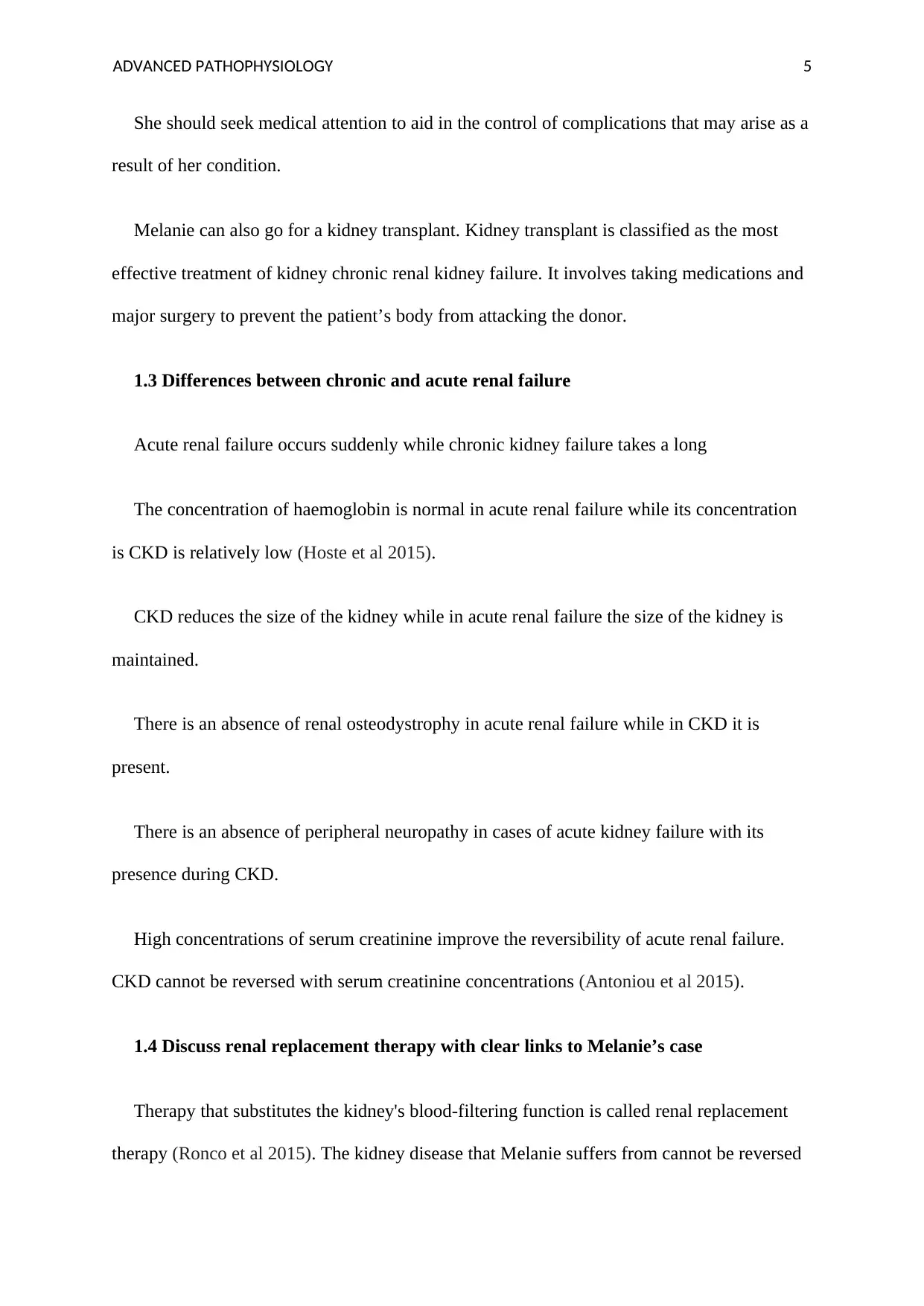
ADVANCED PATHOPHYSIOLOGY 5
She should seek medical attention to aid in the control of complications that may arise as a
result of her condition.
Melanie can also go for a kidney transplant. Kidney transplant is classified as the most
effective treatment of kidney chronic renal kidney failure. It involves taking medications and
major surgery to prevent the patient’s body from attacking the donor.
1.3 Differences between chronic and acute renal failure
Acute renal failure occurs suddenly while chronic kidney failure takes a long
The concentration of haemoglobin is normal in acute renal failure while its concentration
is CKD is relatively low (Hoste et al 2015).
CKD reduces the size of the kidney while in acute renal failure the size of the kidney is
maintained.
There is an absence of renal osteodystrophy in acute renal failure while in CKD it is
present.
There is an absence of peripheral neuropathy in cases of acute kidney failure with its
presence during CKD.
High concentrations of serum creatinine improve the reversibility of acute renal failure.
CKD cannot be reversed with serum creatinine concentrations (Antoniou et al 2015).
1.4 Discuss renal replacement therapy with clear links to Melanie’s case
Therapy that substitutes the kidney's blood-filtering function is called renal replacement
therapy (Ronco et al 2015). The kidney disease that Melanie suffers from cannot be reversed
She should seek medical attention to aid in the control of complications that may arise as a
result of her condition.
Melanie can also go for a kidney transplant. Kidney transplant is classified as the most
effective treatment of kidney chronic renal kidney failure. It involves taking medications and
major surgery to prevent the patient’s body from attacking the donor.
1.3 Differences between chronic and acute renal failure
Acute renal failure occurs suddenly while chronic kidney failure takes a long
The concentration of haemoglobin is normal in acute renal failure while its concentration
is CKD is relatively low (Hoste et al 2015).
CKD reduces the size of the kidney while in acute renal failure the size of the kidney is
maintained.
There is an absence of renal osteodystrophy in acute renal failure while in CKD it is
present.
There is an absence of peripheral neuropathy in cases of acute kidney failure with its
presence during CKD.
High concentrations of serum creatinine improve the reversibility of acute renal failure.
CKD cannot be reversed with serum creatinine concentrations (Antoniou et al 2015).
1.4 Discuss renal replacement therapy with clear links to Melanie’s case
Therapy that substitutes the kidney's blood-filtering function is called renal replacement
therapy (Ronco et al 2015). The kidney disease that Melanie suffers from cannot be reversed
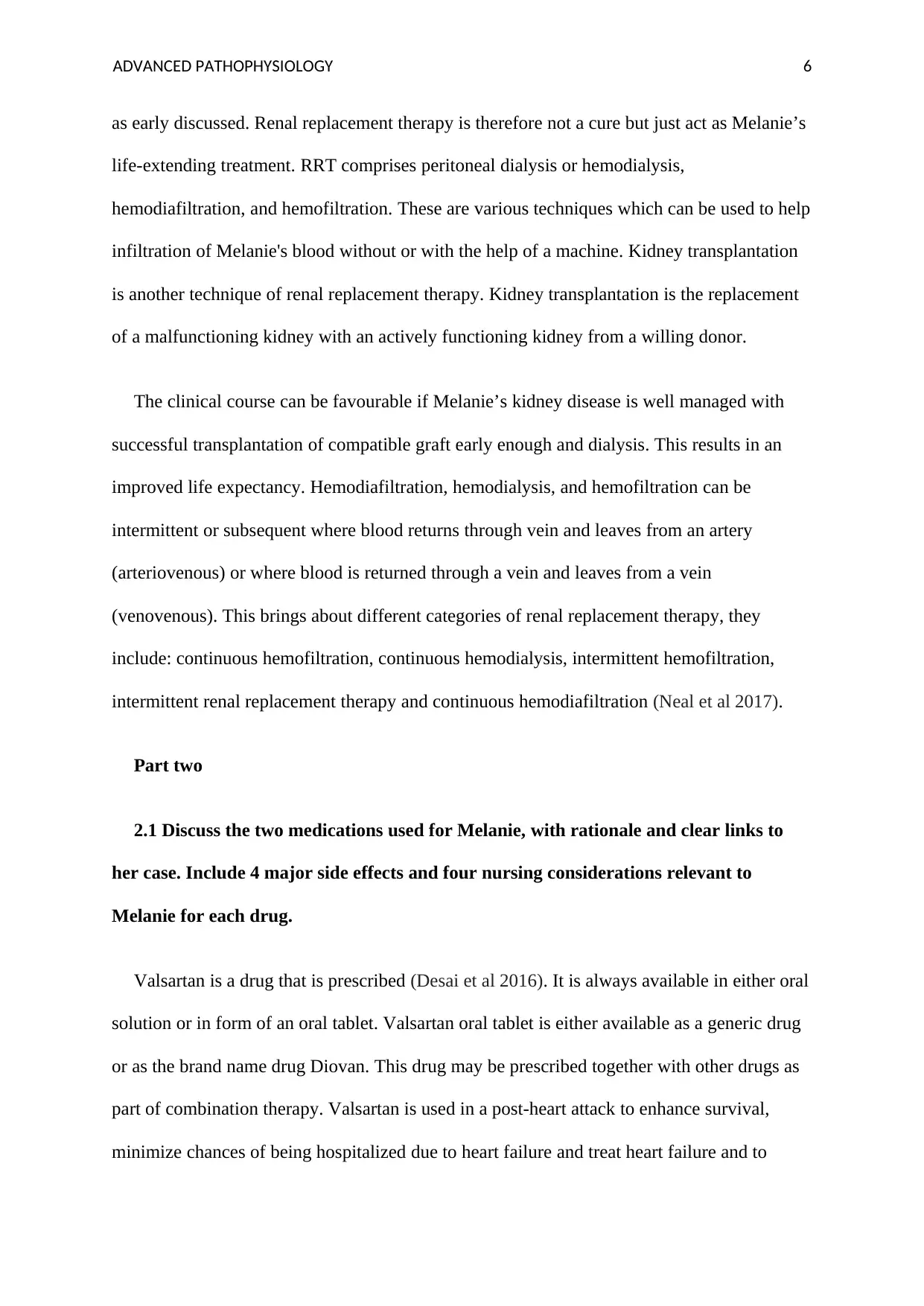
ADVANCED PATHOPHYSIOLOGY 6
as early discussed. Renal replacement therapy is therefore not a cure but just act as Melanie’s
life-extending treatment. RRT comprises peritoneal dialysis or hemodialysis,
hemodiafiltration, and hemofiltration. These are various techniques which can be used to help
infiltration of Melanie's blood without or with the help of a machine. Kidney transplantation
is another technique of renal replacement therapy. Kidney transplantation is the replacement
of a malfunctioning kidney with an actively functioning kidney from a willing donor.
The clinical course can be favourable if Melanie’s kidney disease is well managed with
successful transplantation of compatible graft early enough and dialysis. This results in an
improved life expectancy. Hemodiafiltration, hemodialysis, and hemofiltration can be
intermittent or subsequent where blood returns through vein and leaves from an artery
(arteriovenous) or where blood is returned through a vein and leaves from a vein
(venovenous). This brings about different categories of renal replacement therapy, they
include: continuous hemofiltration, continuous hemodialysis, intermittent hemofiltration,
intermittent renal replacement therapy and continuous hemodiafiltration (Neal et al 2017).
Part two
2.1 Discuss the two medications used for Melanie, with rationale and clear links to
her case. Include 4 major side effects and four nursing considerations relevant to
Melanie for each drug.
Valsartan is a drug that is prescribed (Desai et al 2016). It is always available in either oral
solution or in form of an oral tablet. Valsartan oral tablet is either available as a generic drug
or as the brand name drug Diovan. This drug may be prescribed together with other drugs as
part of combination therapy. Valsartan is used in a post-heart attack to enhance survival,
minimize chances of being hospitalized due to heart failure and treat heart failure and to
as early discussed. Renal replacement therapy is therefore not a cure but just act as Melanie’s
life-extending treatment. RRT comprises peritoneal dialysis or hemodialysis,
hemodiafiltration, and hemofiltration. These are various techniques which can be used to help
infiltration of Melanie's blood without or with the help of a machine. Kidney transplantation
is another technique of renal replacement therapy. Kidney transplantation is the replacement
of a malfunctioning kidney with an actively functioning kidney from a willing donor.
The clinical course can be favourable if Melanie’s kidney disease is well managed with
successful transplantation of compatible graft early enough and dialysis. This results in an
improved life expectancy. Hemodiafiltration, hemodialysis, and hemofiltration can be
intermittent or subsequent where blood returns through vein and leaves from an artery
(arteriovenous) or where blood is returned through a vein and leaves from a vein
(venovenous). This brings about different categories of renal replacement therapy, they
include: continuous hemofiltration, continuous hemodialysis, intermittent hemofiltration,
intermittent renal replacement therapy and continuous hemodiafiltration (Neal et al 2017).
Part two
2.1 Discuss the two medications used for Melanie, with rationale and clear links to
her case. Include 4 major side effects and four nursing considerations relevant to
Melanie for each drug.
Valsartan is a drug that is prescribed (Desai et al 2016). It is always available in either oral
solution or in form of an oral tablet. Valsartan oral tablet is either available as a generic drug
or as the brand name drug Diovan. This drug may be prescribed together with other drugs as
part of combination therapy. Valsartan is used in a post-heart attack to enhance survival,
minimize chances of being hospitalized due to heart failure and treat heart failure and to
⊘ This is a preview!⊘
Do you want full access?
Subscribe today to unlock all pages.

Trusted by 1+ million students worldwide
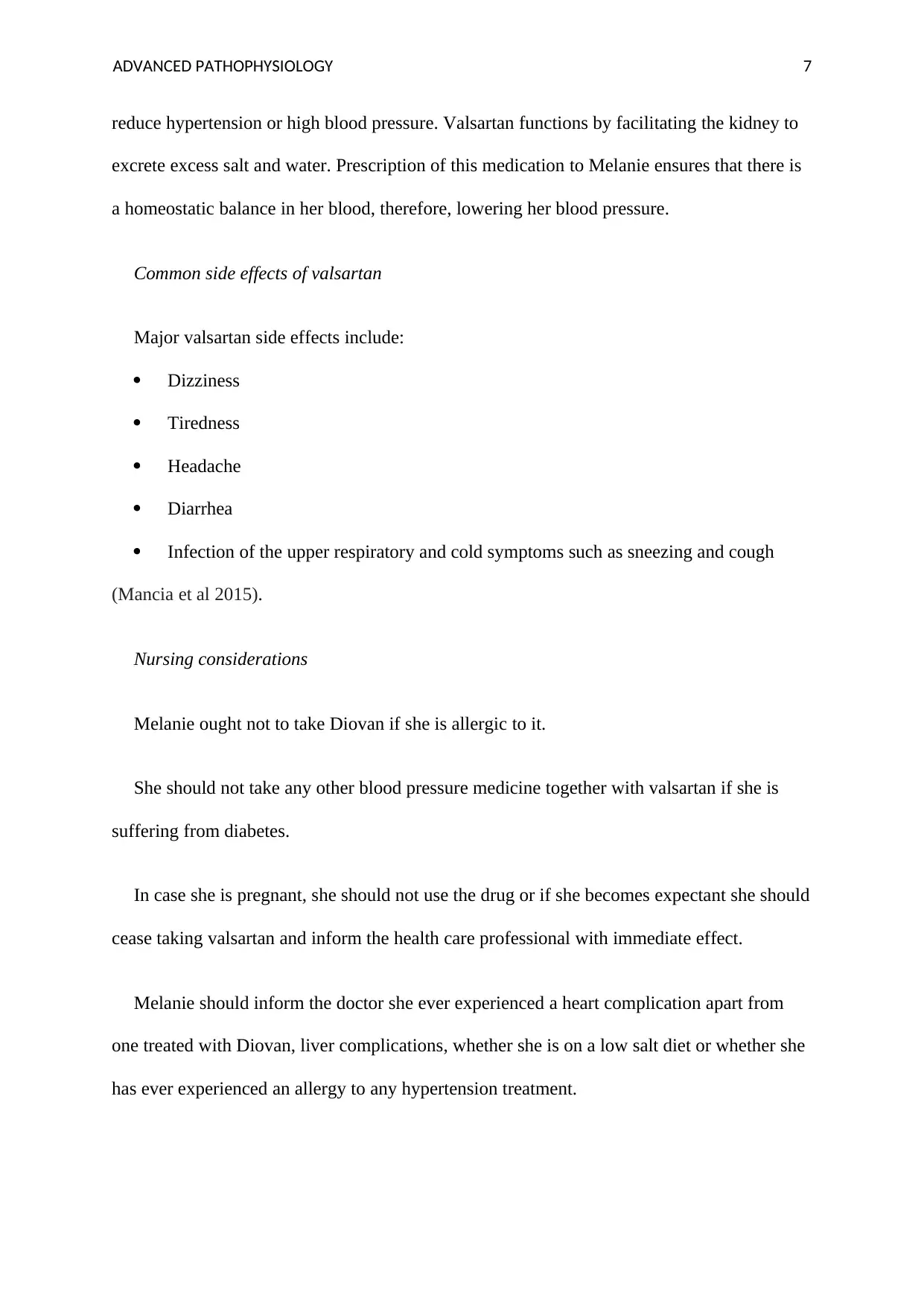
ADVANCED PATHOPHYSIOLOGY 7
reduce hypertension or high blood pressure. Valsartan functions by facilitating the kidney to
excrete excess salt and water. Prescription of this medication to Melanie ensures that there is
a homeostatic balance in her blood, therefore, lowering her blood pressure.
Common side effects of valsartan
Major valsartan side effects include:
Dizziness
Tiredness
Headache
Diarrhea
Infection of the upper respiratory and cold symptoms such as sneezing and cough
(Mancia et al 2015).
Nursing considerations
Melanie ought not to take Diovan if she is allergic to it.
She should not take any other blood pressure medicine together with valsartan if she is
suffering from diabetes.
In case she is pregnant, she should not use the drug or if she becomes expectant she should
cease taking valsartan and inform the health care professional with immediate effect.
Melanie should inform the doctor she ever experienced a heart complication apart from
one treated with Diovan, liver complications, whether she is on a low salt diet or whether she
has ever experienced an allergy to any hypertension treatment.
reduce hypertension or high blood pressure. Valsartan functions by facilitating the kidney to
excrete excess salt and water. Prescription of this medication to Melanie ensures that there is
a homeostatic balance in her blood, therefore, lowering her blood pressure.
Common side effects of valsartan
Major valsartan side effects include:
Dizziness
Tiredness
Headache
Diarrhea
Infection of the upper respiratory and cold symptoms such as sneezing and cough
(Mancia et al 2015).
Nursing considerations
Melanie ought not to take Diovan if she is allergic to it.
She should not take any other blood pressure medicine together with valsartan if she is
suffering from diabetes.
In case she is pregnant, she should not use the drug or if she becomes expectant she should
cease taking valsartan and inform the health care professional with immediate effect.
Melanie should inform the doctor she ever experienced a heart complication apart from
one treated with Diovan, liver complications, whether she is on a low salt diet or whether she
has ever experienced an allergy to any hypertension treatment.
Paraphrase This Document
Need a fresh take? Get an instant paraphrase of this document with our AI Paraphraser
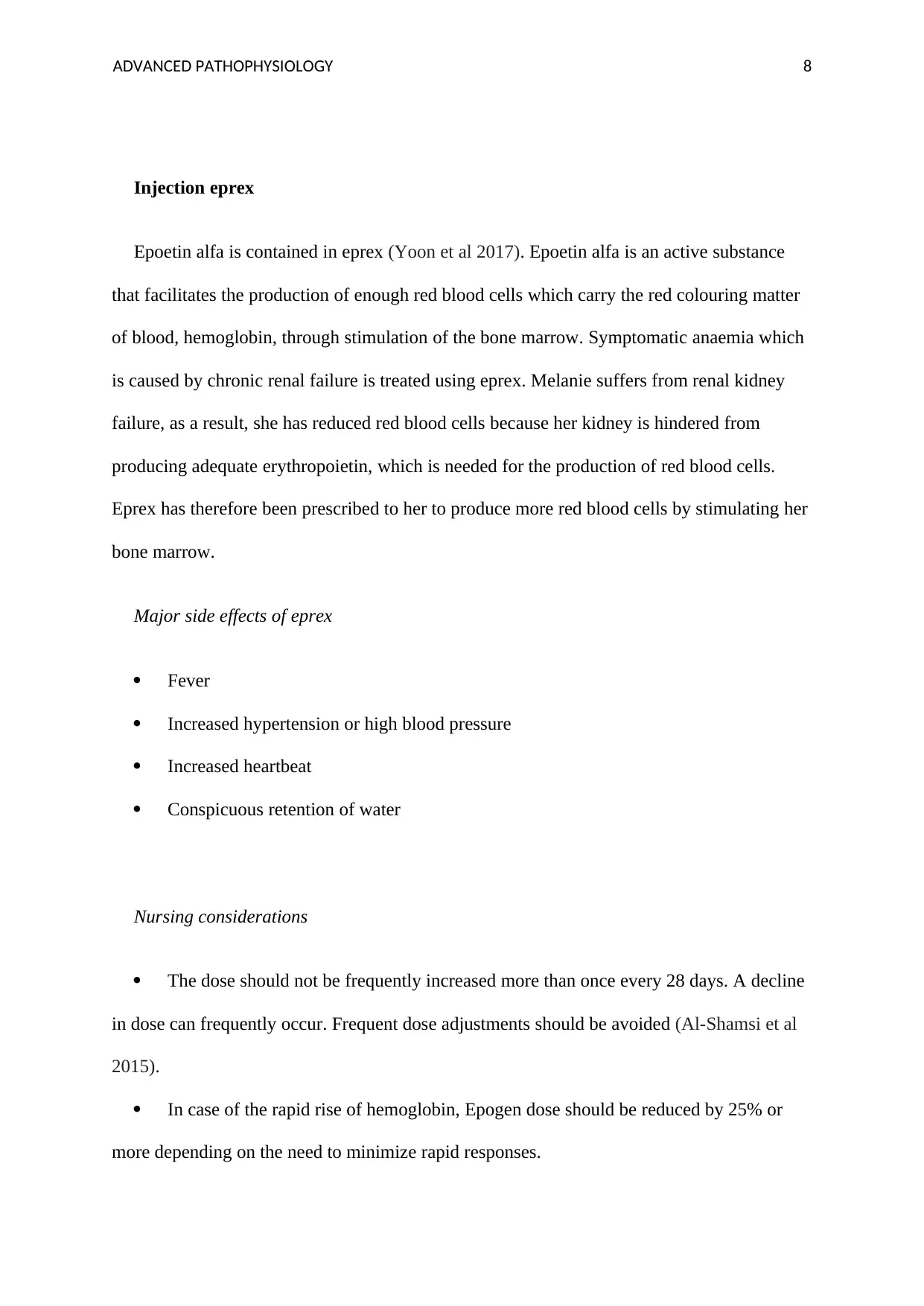
ADVANCED PATHOPHYSIOLOGY 8
Injection eprex
Epoetin alfa is contained in eprex (Yoon et al 2017). Epoetin alfa is an active substance
that facilitates the production of enough red blood cells which carry the red colouring matter
of blood, hemoglobin, through stimulation of the bone marrow. Symptomatic anaemia which
is caused by chronic renal failure is treated using eprex. Melanie suffers from renal kidney
failure, as a result, she has reduced red blood cells because her kidney is hindered from
producing adequate erythropoietin, which is needed for the production of red blood cells.
Eprex has therefore been prescribed to her to produce more red blood cells by stimulating her
bone marrow.
Major side effects of eprex
Fever
Increased hypertension or high blood pressure
Increased heartbeat
Conspicuous retention of water
Nursing considerations
The dose should not be frequently increased more than once every 28 days. A decline
in dose can frequently occur. Frequent dose adjustments should be avoided (Al-Shamsi et al
2015).
In case of the rapid rise of hemoglobin, Epogen dose should be reduced by 25% or
more depending on the need to minimize rapid responses.
Injection eprex
Epoetin alfa is contained in eprex (Yoon et al 2017). Epoetin alfa is an active substance
that facilitates the production of enough red blood cells which carry the red colouring matter
of blood, hemoglobin, through stimulation of the bone marrow. Symptomatic anaemia which
is caused by chronic renal failure is treated using eprex. Melanie suffers from renal kidney
failure, as a result, she has reduced red blood cells because her kidney is hindered from
producing adequate erythropoietin, which is needed for the production of red blood cells.
Eprex has therefore been prescribed to her to produce more red blood cells by stimulating her
bone marrow.
Major side effects of eprex
Fever
Increased hypertension or high blood pressure
Increased heartbeat
Conspicuous retention of water
Nursing considerations
The dose should not be frequently increased more than once every 28 days. A decline
in dose can frequently occur. Frequent dose adjustments should be avoided (Al-Shamsi et al
2015).
In case of the rapid rise of hemoglobin, Epogen dose should be reduced by 25% or
more depending on the need to minimize rapid responses.
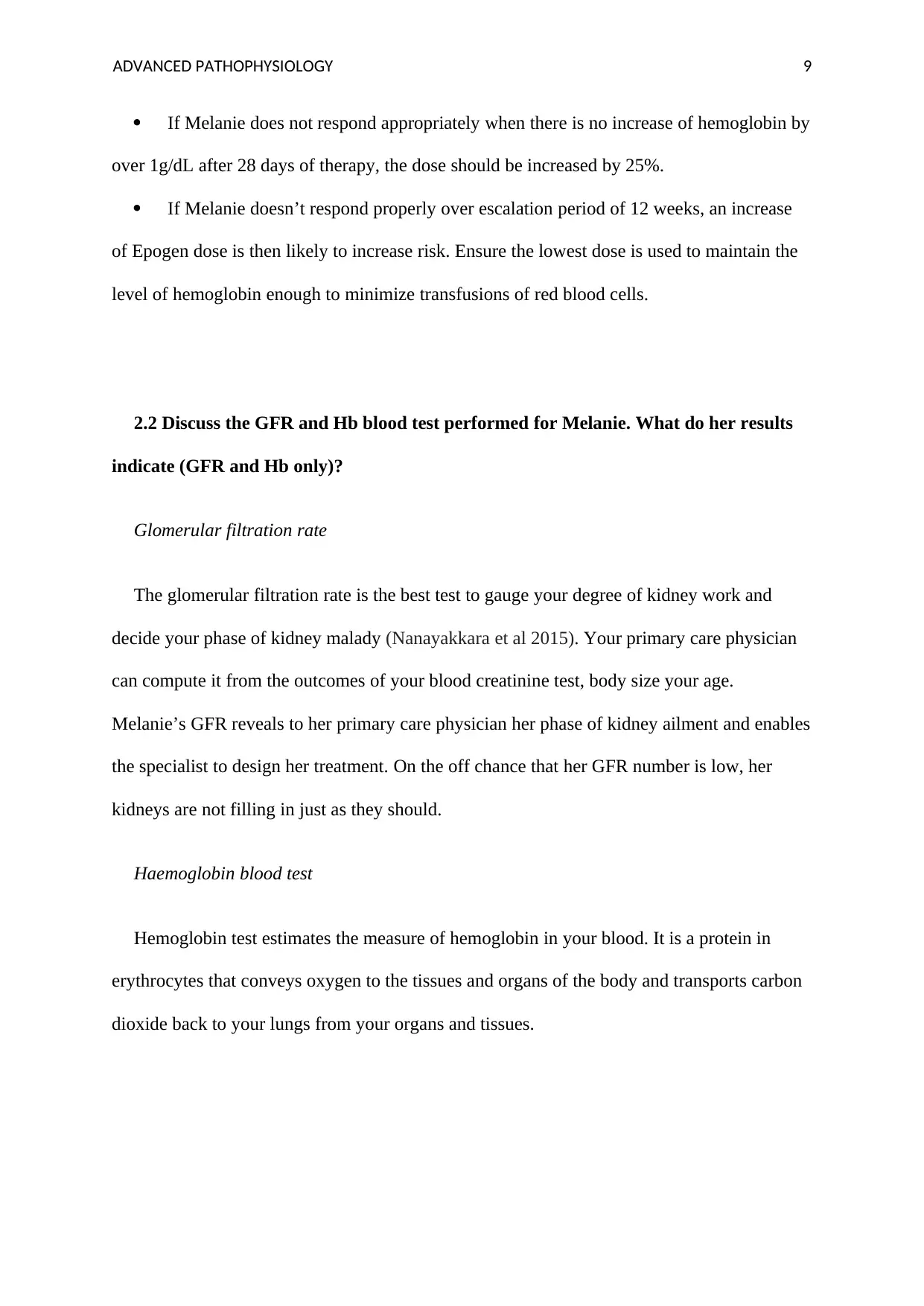
ADVANCED PATHOPHYSIOLOGY 9
If Melanie does not respond appropriately when there is no increase of hemoglobin by
over 1g/dL after 28 days of therapy, the dose should be increased by 25%.
If Melanie doesn’t respond properly over escalation period of 12 weeks, an increase
of Epogen dose is then likely to increase risk. Ensure the lowest dose is used to maintain the
level of hemoglobin enough to minimize transfusions of red blood cells.
2.2 Discuss the GFR and Hb blood test performed for Melanie. What do her results
indicate (GFR and Hb only)?
Glomerular filtration rate
The glomerular filtration rate is the best test to gauge your degree of kidney work and
decide your phase of kidney malady (Nanayakkara et al 2015). Your primary care physician
can compute it from the outcomes of your blood creatinine test, body size your age.
Melanie’s GFR reveals to her primary care physician her phase of kidney ailment and enables
the specialist to design her treatment. On the off chance that her GFR number is low, her
kidneys are not filling in just as they should.
Haemoglobin blood test
Hemoglobin test estimates the measure of hemoglobin in your blood. It is a protein in
erythrocytes that conveys oxygen to the tissues and organs of the body and transports carbon
dioxide back to your lungs from your organs and tissues.
If Melanie does not respond appropriately when there is no increase of hemoglobin by
over 1g/dL after 28 days of therapy, the dose should be increased by 25%.
If Melanie doesn’t respond properly over escalation period of 12 weeks, an increase
of Epogen dose is then likely to increase risk. Ensure the lowest dose is used to maintain the
level of hemoglobin enough to minimize transfusions of red blood cells.
2.2 Discuss the GFR and Hb blood test performed for Melanie. What do her results
indicate (GFR and Hb only)?
Glomerular filtration rate
The glomerular filtration rate is the best test to gauge your degree of kidney work and
decide your phase of kidney malady (Nanayakkara et al 2015). Your primary care physician
can compute it from the outcomes of your blood creatinine test, body size your age.
Melanie’s GFR reveals to her primary care physician her phase of kidney ailment and enables
the specialist to design her treatment. On the off chance that her GFR number is low, her
kidneys are not filling in just as they should.
Haemoglobin blood test
Hemoglobin test estimates the measure of hemoglobin in your blood. It is a protein in
erythrocytes that conveys oxygen to the tissues and organs of the body and transports carbon
dioxide back to your lungs from your organs and tissues.
⊘ This is a preview!⊘
Do you want full access?
Subscribe today to unlock all pages.

Trusted by 1+ million students worldwide
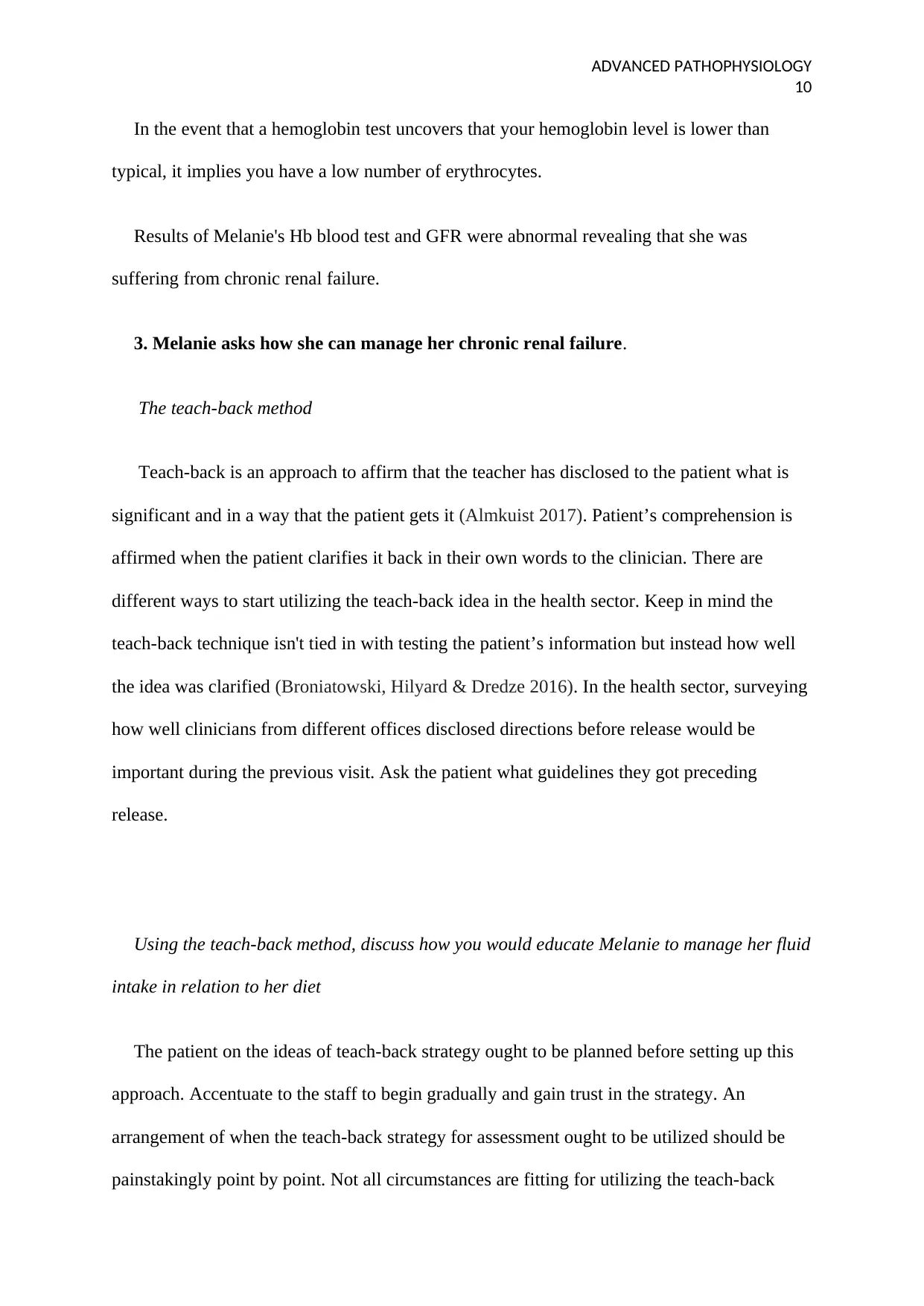
ADVANCED PATHOPHYSIOLOGY
10
In the event that a hemoglobin test uncovers that your hemoglobin level is lower than
typical, it implies you have a low number of erythrocytes.
Results of Melanie's Hb blood test and GFR were abnormal revealing that she was
suffering from chronic renal failure.
3. Melanie asks how she can manage her chronic renal failure.
The teach-back method
Teach-back is an approach to affirm that the teacher has disclosed to the patient what is
significant and in a way that the patient gets it (Almkuist 2017). Patient’s comprehension is
affirmed when the patient clarifies it back in their own words to the clinician. There are
different ways to start utilizing the teach-back idea in the health sector. Keep in mind the
teach-back technique isn't tied in with testing the patient’s information but instead how well
the idea was clarified (Broniatowski, Hilyard & Dredze 2016). In the health sector, surveying
how well clinicians from different offices disclosed directions before release would be
important during the previous visit. Ask the patient what guidelines they got preceding
release.
Using the teach-back method, discuss how you would educate Melanie to manage her fluid
intake in relation to her diet
The patient on the ideas of teach-back strategy ought to be planned before setting up this
approach. Accentuate to the staff to begin gradually and gain trust in the strategy. An
arrangement of when the teach-back strategy for assessment ought to be utilized should be
painstakingly point by point. Not all circumstances are fitting for utilizing the teach-back
10
In the event that a hemoglobin test uncovers that your hemoglobin level is lower than
typical, it implies you have a low number of erythrocytes.
Results of Melanie's Hb blood test and GFR were abnormal revealing that she was
suffering from chronic renal failure.
3. Melanie asks how she can manage her chronic renal failure.
The teach-back method
Teach-back is an approach to affirm that the teacher has disclosed to the patient what is
significant and in a way that the patient gets it (Almkuist 2017). Patient’s comprehension is
affirmed when the patient clarifies it back in their own words to the clinician. There are
different ways to start utilizing the teach-back idea in the health sector. Keep in mind the
teach-back technique isn't tied in with testing the patient’s information but instead how well
the idea was clarified (Broniatowski, Hilyard & Dredze 2016). In the health sector, surveying
how well clinicians from different offices disclosed directions before release would be
important during the previous visit. Ask the patient what guidelines they got preceding
release.
Using the teach-back method, discuss how you would educate Melanie to manage her fluid
intake in relation to her diet
The patient on the ideas of teach-back strategy ought to be planned before setting up this
approach. Accentuate to the staff to begin gradually and gain trust in the strategy. An
arrangement of when the teach-back strategy for assessment ought to be utilized should be
painstakingly point by point. Not all circumstances are fitting for utilizing the teach-back
Paraphrase This Document
Need a fresh take? Get an instant paraphrase of this document with our AI Paraphraser
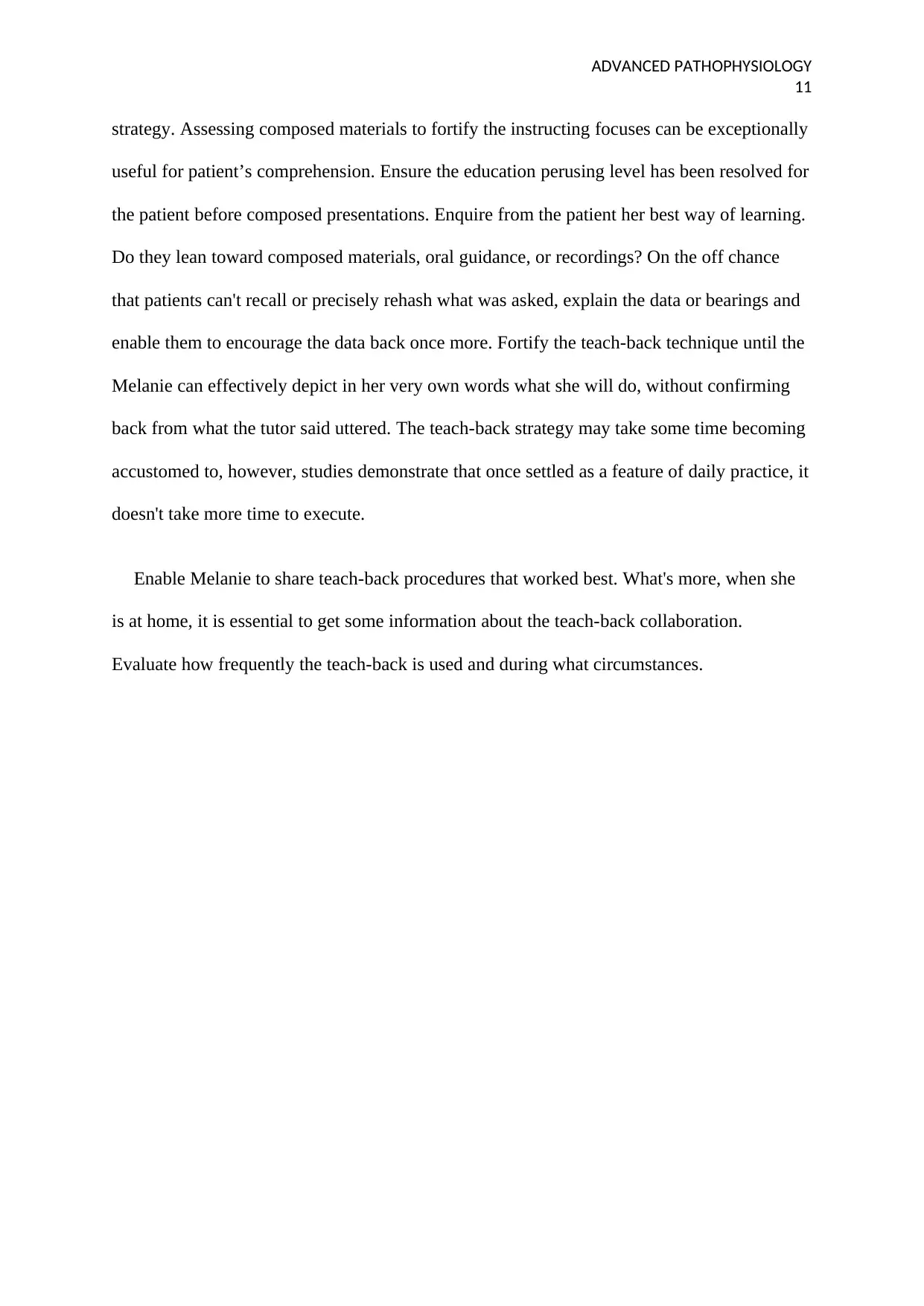
ADVANCED PATHOPHYSIOLOGY
11
strategy. Assessing composed materials to fortify the instructing focuses can be exceptionally
useful for patient’s comprehension. Ensure the education perusing level has been resolved for
the patient before composed presentations. Enquire from the patient her best way of learning.
Do they lean toward composed materials, oral guidance, or recordings? On the off chance
that patients can't recall or precisely rehash what was asked, explain the data or bearings and
enable them to encourage the data back once more. Fortify the teach-back technique until the
Melanie can effectively depict in her very own words what she will do, without confirming
back from what the tutor said uttered. The teach-back strategy may take some time becoming
accustomed to, however, studies demonstrate that once settled as a feature of daily practice, it
doesn't take more time to execute.
Enable Melanie to share teach-back procedures that worked best. What's more, when she
is at home, it is essential to get some information about the teach-back collaboration.
Evaluate how frequently the teach-back is used and during what circumstances.
11
strategy. Assessing composed materials to fortify the instructing focuses can be exceptionally
useful for patient’s comprehension. Ensure the education perusing level has been resolved for
the patient before composed presentations. Enquire from the patient her best way of learning.
Do they lean toward composed materials, oral guidance, or recordings? On the off chance
that patients can't recall or precisely rehash what was asked, explain the data or bearings and
enable them to encourage the data back once more. Fortify the teach-back technique until the
Melanie can effectively depict in her very own words what she will do, without confirming
back from what the tutor said uttered. The teach-back strategy may take some time becoming
accustomed to, however, studies demonstrate that once settled as a feature of daily practice, it
doesn't take more time to execute.
Enable Melanie to share teach-back procedures that worked best. What's more, when she
is at home, it is essential to get some information about the teach-back collaboration.
Evaluate how frequently the teach-back is used and during what circumstances.
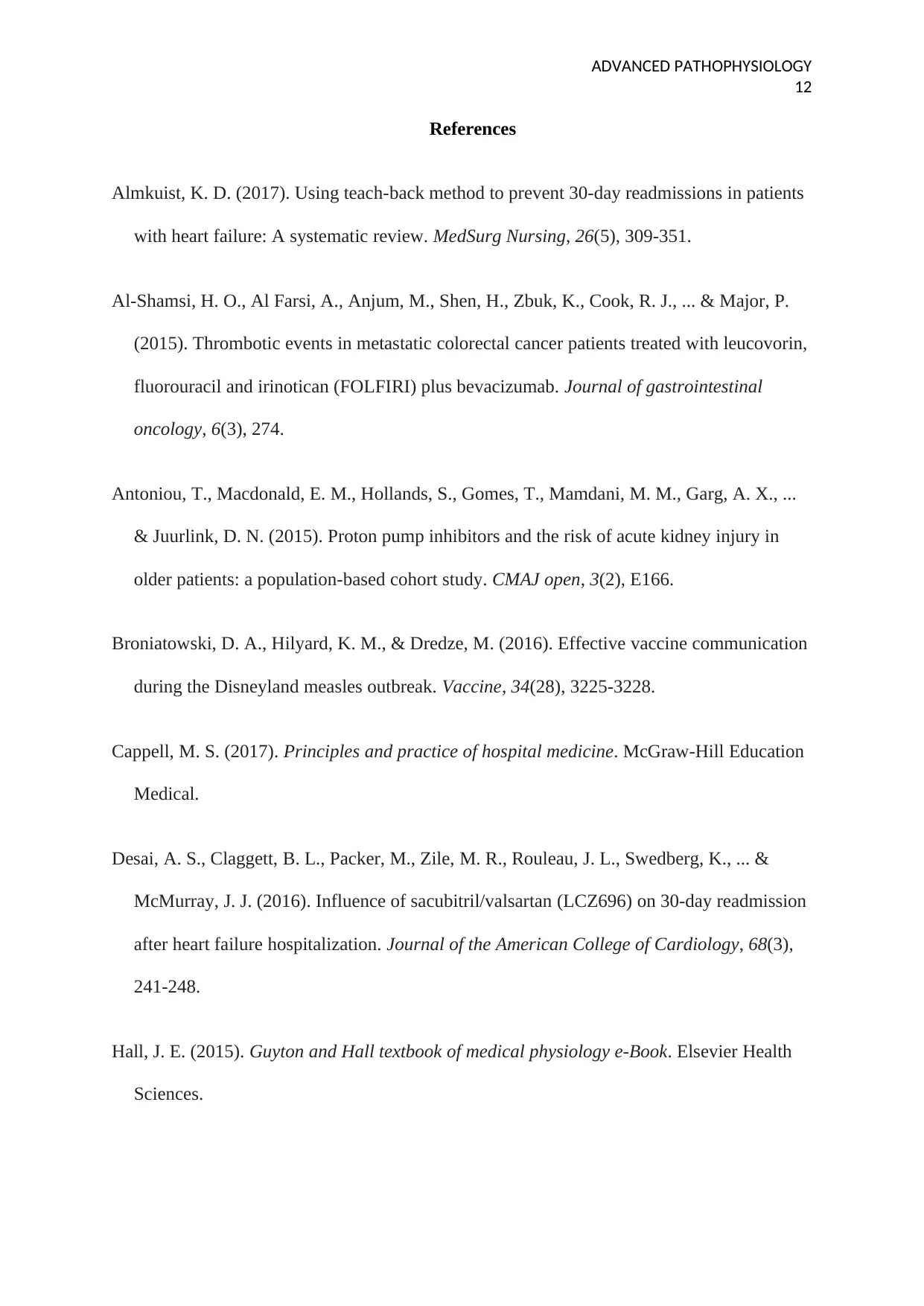
ADVANCED PATHOPHYSIOLOGY
12
References
Almkuist, K. D. (2017). Using teach-back method to prevent 30-day readmissions in patients
with heart failure: A systematic review. MedSurg Nursing, 26(5), 309-351.
Al-Shamsi, H. O., Al Farsi, A., Anjum, M., Shen, H., Zbuk, K., Cook, R. J., ... & Major, P.
(2015). Thrombotic events in metastatic colorectal cancer patients treated with leucovorin,
fluorouracil and irinotican (FOLFIRI) plus bevacizumab. Journal of gastrointestinal
oncology, 6(3), 274.
Antoniou, T., Macdonald, E. M., Hollands, S., Gomes, T., Mamdani, M. M., Garg, A. X., ...
& Juurlink, D. N. (2015). Proton pump inhibitors and the risk of acute kidney injury in
older patients: a population-based cohort study. CMAJ open, 3(2), E166.
Broniatowski, D. A., Hilyard, K. M., & Dredze, M. (2016). Effective vaccine communication
during the Disneyland measles outbreak. Vaccine, 34(28), 3225-3228.
Cappell, M. S. (2017). Principles and practice of hospital medicine. McGraw-Hill Education
Medical.
Desai, A. S., Claggett, B. L., Packer, M., Zile, M. R., Rouleau, J. L., Swedberg, K., ... &
McMurray, J. J. (2016). Influence of sacubitril/valsartan (LCZ696) on 30-day readmission
after heart failure hospitalization. Journal of the American College of Cardiology, 68(3),
241-248.
Hall, J. E. (2015). Guyton and Hall textbook of medical physiology e-Book. Elsevier Health
Sciences.
12
References
Almkuist, K. D. (2017). Using teach-back method to prevent 30-day readmissions in patients
with heart failure: A systematic review. MedSurg Nursing, 26(5), 309-351.
Al-Shamsi, H. O., Al Farsi, A., Anjum, M., Shen, H., Zbuk, K., Cook, R. J., ... & Major, P.
(2015). Thrombotic events in metastatic colorectal cancer patients treated with leucovorin,
fluorouracil and irinotican (FOLFIRI) plus bevacizumab. Journal of gastrointestinal
oncology, 6(3), 274.
Antoniou, T., Macdonald, E. M., Hollands, S., Gomes, T., Mamdani, M. M., Garg, A. X., ...
& Juurlink, D. N. (2015). Proton pump inhibitors and the risk of acute kidney injury in
older patients: a population-based cohort study. CMAJ open, 3(2), E166.
Broniatowski, D. A., Hilyard, K. M., & Dredze, M. (2016). Effective vaccine communication
during the Disneyland measles outbreak. Vaccine, 34(28), 3225-3228.
Cappell, M. S. (2017). Principles and practice of hospital medicine. McGraw-Hill Education
Medical.
Desai, A. S., Claggett, B. L., Packer, M., Zile, M. R., Rouleau, J. L., Swedberg, K., ... &
McMurray, J. J. (2016). Influence of sacubitril/valsartan (LCZ696) on 30-day readmission
after heart failure hospitalization. Journal of the American College of Cardiology, 68(3),
241-248.
Hall, J. E. (2015). Guyton and Hall textbook of medical physiology e-Book. Elsevier Health
Sciences.
⊘ This is a preview!⊘
Do you want full access?
Subscribe today to unlock all pages.

Trusted by 1+ million students worldwide
1 out of 14
Related Documents
Your All-in-One AI-Powered Toolkit for Academic Success.
+13062052269
info@desklib.com
Available 24*7 on WhatsApp / Email
![[object Object]](/_next/static/media/star-bottom.7253800d.svg)
Unlock your academic potential
Copyright © 2020–2025 A2Z Services. All Rights Reserved. Developed and managed by ZUCOL.





